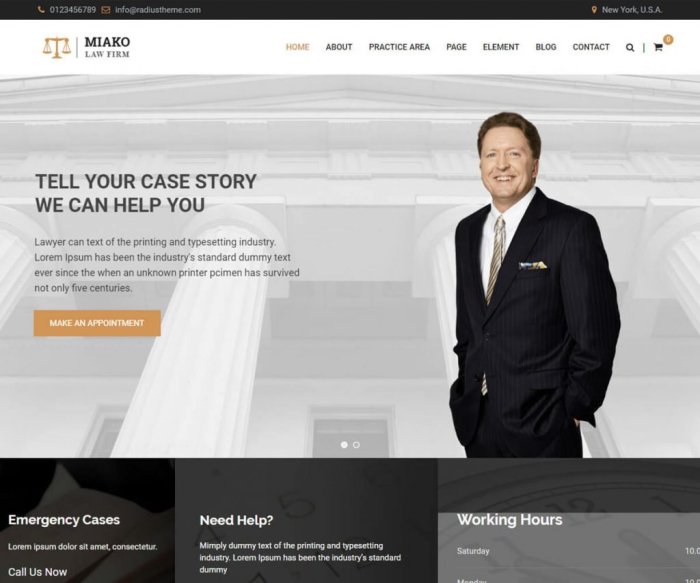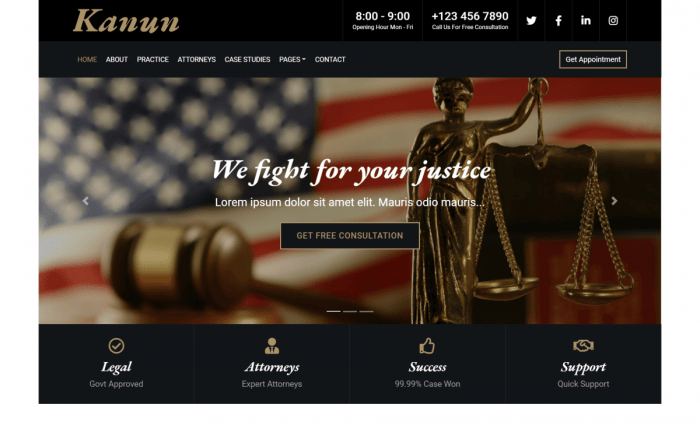This comprehensive guide delves into the creation of a professional and effective HTML template for law firms, catering to the specific needs of barristers, lawyers, and attorneys. We’ll explore the distinctions between these legal professionals, examine crucial website design elements, and provide practical advice on content strategy, visual branding, and legal compliance. The goal is to equip you with the knowledge to build a website that not only showcases your expertise but also attracts and retains clients.
From understanding the nuances of legal terminology and the varying roles of barristers, lawyers, and attorneys across different jurisdictions, to mastering the technical aspects of HTML, JavaScript, and best practices, this guide offers a holistic approach to website development for legal professionals. We will cover essential features such as contact forms, appointment scheduling, and accessibility considerations, ensuring your website is both user-friendly and compliant with relevant regulations.
Barrister, Lawyer, Attorney Definitions and Differences
The terms barrister, lawyer, and attorney are often used interchangeably, leading to confusion. However, their meanings and roles vary significantly depending on the legal system. This explanation clarifies the distinctions between these legal professionals, focusing primarily on the common law systems of the UK and the US, while acknowledging variations in other jurisdictions.
Definitions and Distinctions in Common Law Systems
In the UK, the legal profession is traditionally divided into barristers and solicitors. Barristers are specialized advocates who represent clients in court. Solicitors handle the legal work outside of court, such as advising clients, preparing legal documents, and conducting investigations. In contrast, the US legal system typically uses the term “lawyer” as a broad category encompassing all legal professionals, with “attorney” often used interchangeably. However, some states make a distinction, reserving “attorney” for those licensed to practice before a court. There is no direct equivalent to the UK barrister/solicitor split in the US. Many US lawyers handle both courtroom advocacy and out-of-court legal work.
Examples of Suitable Legal Professionals for Specific Cases
A complex commercial dispute involving significant financial stakes would likely benefit from the expertise of both a solicitor (for pre-trial preparation and document review) and a barrister (for courtroom advocacy). A relatively straightforward personal injury claim might only require a solicitor to handle all aspects of the case. In the US, a lawyer specializing in personal injury would manage all stages, from initial consultation to trial. A high-profile criminal case might involve a team of lawyers, with some focusing on investigation and legal strategy and others specializing in courtroom presentation.
Comparison Table: Roles, Responsibilities, and Jurisdictions
| Role | UK Barrister | UK Solicitor | US Lawyer/Attorney |
|---|---|---|---|
| Primary Function | Court advocacy, expert legal argument | Client advising, legal document preparation, pre-trial work | Broad range, including advocacy, advising, and legal work |
| Court Appearances | Frequent, primary role | Infrequent, usually only in lower courts | Varies depending on specialization and case |
| Client Interaction | Indirect, often through solicitor | Direct, primary client contact | Direct, primary client contact |
| Jurisdiction | Specific courts and jurisdictions | Specific courts and jurisdictions | State-specific licensing, potential for federal practice |
Law Firm Website Design Considerations
A well-designed website is crucial for any modern law firm. It serves as the firm’s digital storefront, attracting potential clients and showcasing expertise. A user-friendly and informative website can significantly impact client acquisition and the overall perception of the firm’s professionalism. Effective design balances aesthetics with functionality, creating a positive online experience that builds trust and encourages engagement.
Effective law firm website design requires a strategic approach that considers both visual appeal and practical functionality. The goal is to create a site that is not only visually appealing but also easy to navigate and provides the information clients need quickly and efficiently. This includes clear calls to action, easily accessible contact information, and a design that prioritizes the user experience above all else.
Website Layout Emphasizing User Experience
A successful law firm website prioritizes user experience (UX). The layout should be intuitive and straightforward, guiding visitors seamlessly through the site’s content. Consider a clean, uncluttered design with a clear hierarchy of information. Important elements, such as contact information and practice areas, should be prominently displayed. A logical navigation menu allows visitors to easily find what they need. The use of whitespace effectively separates content, preventing the site from feeling overwhelming. A visually appealing layout, using high-quality imagery and professional fonts, can enhance the firm’s credibility and professionalism. Imagine a site where a visitor can instantly find the firm’s phone number, location, and a brief description of their key practice areas within seconds of landing on the homepage.
Essential Features for a Modern Law Firm Website
A modern law firm website needs several key features to be effective. These features enhance user experience, improve accessibility, and help attract new clients.
- Responsive Design: Adapts seamlessly to various screen sizes (desktops, tablets, smartphones).
- Clear and Concise Content: Easy-to-understand language, avoiding legal jargon.
- Prominent Call-to-Actions (CTAs): Encouraging visitors to contact the firm or schedule a consultation.
- Client Testimonials and Reviews: Building trust and credibility through social proof.
- Blog: Sharing legal insights and firm news, enhancing and establishing thought leadership.
- Secure Contact Form: Facilitating easy communication with potential clients.
- Attorney Profiles: Showcasing individual expertise and experience.
- Practice Area Pages: Detailed information on the services offered.
- FAQ Section: Addressing common client questions.
- Accessibility Features: Ensuring the site is usable by people with disabilities.
Importance of Mobile Responsiveness
Mobile responsiveness is paramount for a law firm website. With a significant portion of internet users accessing websites via smartphones and tablets, a non-responsive site will frustrate potential clients and negatively impact the firm’s online presence. A responsive design ensures the website adapts seamlessly to different screen sizes, maintaining readability and usability across all devices. This improves user experience, leading to higher engagement and conversion rates. For example, a client searching for a personal injury lawyer on their phone should be able to easily access the firm’s contact information, read attorney bios, and learn about their services without having to pinch and zoom excessively. A non-responsive site risks losing potential clients who might find it difficult to navigate and simply move on to a competitor.
HTML Template Functionality for Law Firms

A well-designed website is crucial for a law firm’s success, acting as a primary point of contact for potential clients. Effective use of HTML can significantly enhance user experience and improve lead generation. This section details essential HTML elements for creating functional and user-friendly law firm websites.
Contact Form Implementation
A contact form is essential for allowing potential clients to easily reach out. The form should be straightforward and collect necessary information. Below are the core HTML elements required:
<form action="/submit_form" method="post">
<label for="name">Name:</label>
<input type="text" id="name" name="name" required>
<br>
<label for="email">Email:</label>
<input type="email" id="email" name="email" required>
<br>
<label for="message">Message:</label>
<textarea id="message" name="message" rows="4" required></textarea>
<br>
<input type="submit" value="Submit">
</form>
This code snippet demonstrates a basic form with name, email, and message fields. The `action` attribute specifies the server-side script that processes the form data (this would be handled separately, likely using a server-side language like PHP or Node.js). The `required` attribute ensures all fields must be filled. Further enhancements, such as input validation using Javascript, would improve the user experience.
Appointment Scheduling System
Integrating a simple appointment scheduling system can streamline client communication and improve efficiency. While a fully functional system requires server-side integration, a basic HTML and Javascript framework can be implemented. This example uses Javascript to display a confirmation message after a submission:
<form id="appointmentForm" onsubmit="return handleAppointment();">
<!-- Form fields for date, time, etc. -->
<input type="submit" value="Request Appointment">
</form>
<script>
function handleAppointment()
alert("Your appointment request has been submitted. We will contact you shortly.");
return false; // Prevent page reload
</script>
This demonstrates a simple approach. A more sophisticated system would use AJAX to send the appointment data to a server for processing and database storage. The alert is a placeholder; a more robust system might display a more detailed confirmation message or redirect the user to a confirmation page.
Accessibility (WCAG) Compliance Best Practices
Ensuring accessibility is paramount for inclusivity and legal compliance. WCAG (Web Content Accessibility Guidelines) provide a framework for creating accessible websites. Here are some key HTML best practices:
Implementing WCAG compliance requires careful consideration throughout the design and development process. It’s important to remember that this is not an exhaustive list, and further research and testing are crucial for comprehensive compliance.
- Semantic HTML: Use appropriate HTML5 elements (e.g., <header>, <nav>, <main>, <article>, <aside>, <footer>) to structure the content logically. This aids screen readers and assistive technologies in interpreting the page structure.
- Alternative Text for Images: Provide descriptive alternative text (<img alt=”Descriptive text”>) for all images. This allows screen readers to convey the image’s content to visually impaired users.
- Proper Heading Structure: Use heading elements (<h1> to <h6>) in a logical order to structure the content hierarchically. This helps users navigate the page and aids screen readers in understanding the content structure.
- Keyboard Navigation: Ensure all interactive elements (buttons, links, form fields) are accessible using only the keyboard. This is vital for users who cannot use a mouse.
- Sufficient Color Contrast: Use sufficient color contrast between text and background to ensure readability for users with visual impairments. Tools are available to check color contrast ratios.
- ARIA Attributes: Use ARIA (Accessible Rich Internet Applications) attributes where necessary to provide additional semantic information for assistive technologies. This is particularly helpful for complex interactive elements.
Visual Elements and Branding
A law firm’s website is its digital storefront, and its visual presentation significantly impacts client perception. A well-designed site conveys professionalism, trustworthiness, and expertise, encouraging potential clients to engage with the firm’s services. The careful selection of color palettes, typography, and imagery is crucial in achieving this.
Ideal Color Palette and Typography
The choice of colors and fonts should project an image of authority and stability while maintaining a modern and approachable feel. Dark blues, greens, and grays are commonly used, evoking feelings of trust and security. These can be complemented with accents of gold or a muted jewel tone to add a touch of sophistication without being overwhelming. Avoid bright, flashy colors that might appear unprofessional or distracting. For typography, select clean, legible fonts like Garamond, Times New Roman, or a modern sans-serif font such as Open Sans or Lato for body text. A more elegant serif font can be used for headings to create visual hierarchy and a sense of prestige. Consistency in font usage throughout the website is essential for a cohesive and professional look.
High-Quality Images for Enhanced Visual Appeal
High-quality imagery is vital for breaking up text and making the website visually engaging. Images should be professional, high-resolution, and relevant to the firm’s services and values. Examples include:
- A photograph of the firm’s office space, showcasing a modern and well-organized environment. This image could feature natural light, clean lines, and perhaps a glimpse of a team member working diligently.
- An image of a diverse group of lawyers collaborating, emphasizing teamwork and expertise. The image should be candid and show genuine interaction among the team members, suggesting a supportive and collaborative work environment.
- A stylized image representing justice or legal concepts, such as a gavel or scales of justice, subtly incorporated into the design. This could be a modern interpretation, avoiding clichés, and integrated seamlessly into the website’s layout.
- Images of satisfied clients (with their permission, of course, and possibly blurred faces to maintain privacy) offering testimonials, demonstrating the firm’s positive impact. These images should be genuine and reflect positive experiences with the firm.
Incorporating the Firm’s Logo and Branding Elements
The firm’s logo should be prominently displayed on every page of the website, ideally in the header. This ensures immediate brand recognition and reinforces the firm’s identity. Branding elements, such as the firm’s color palette and typography, should be consistently applied throughout the site, from the header and footer to buttons and other interactive elements. This creates a cohesive and professional brand experience for visitors. Maintaining a consistent brand voice and visual identity across all platforms (website, social media, etc.) is crucial for building a strong brand reputation. For instance, if the logo features a specific shade of blue, that same shade should be used consistently throughout the website in headings, buttons, and other design elements.
Best Practices (without using terms)
Making your law firm’s website easily discoverable by potential clients involves several key strategies. A well-optimized website increases your chances of attracting new business organically, meaning without paid advertising. This translates to a more sustainable and cost-effective approach to client acquisition.
Improving your website’s visibility requires a multifaceted approach. It’s not just about the words on the page, but also how easily search engines can understand and index your content. This involves a careful consideration of website structure, content quality, and the overall user experience.
Website Navigation and User Experience
Clear and concise website navigation is crucial for a positive user experience. Visitors should be able to quickly find the information they need, whether it’s your contact details, practice areas, or testimonials. A confusing or poorly structured website will likely lead to frustrated visitors leaving before they’ve had a chance to learn about your services. A logical sitemap, intuitive menus, and prominent calls to action all contribute to a smooth and efficient user journey. Consider using clear and descriptive labels for all navigation elements, ensuring they accurately reflect the content of each page. For example, instead of “Services,” consider using more specific labels like “Family Law,” “Criminal Defense,” or “Personal Injury.”
Structured Data Markup Benefits
Structured data markup, essentially adding specific code to your website’s HTML, helps search engines better understand the content on your pages. This “structured data” provides context and meaning, allowing search engines to display your information more effectively in search results. For example, you could use structured data to highlight your firm’s address, phone number, and business hours, which might then appear directly in the search results, increasing click-through rates. This also improves the accuracy and comprehensiveness of information displayed about your firm, leading to a more trustworthy online presence. A well-structured website, therefore, increases the likelihood of attracting relevant traffic and generating more leads. Consider using schema.org vocabulary for a standardized approach to structured data implementation.
Legal Considerations for Website Content

Creating a law firm website requires careful consideration of legal implications to maintain professionalism, protect client confidentiality, and avoid potential legal issues. This section Artikels key legal aspects to ensure your website operates within the bounds of the law and maintains public trust.
The content of your website, from disclaimers to client testimonials, must adhere to legal standards and ethical guidelines. Failure to do so can result in legal repercussions and damage your firm’s reputation.
Disclaimers and Legal Notices
Including clear and comprehensive disclaimers and legal notices is crucial for protecting your law firm from liability. These statements manage expectations and clarify the limitations of the information presented on your website. They are not merely a formality; they are a necessary safeguard.
A disclaimer should clearly state that the information provided on the website is for general informational purposes only and does not constitute legal advice. It should also specify that a lawyer-client relationship is not established through website interaction. A privacy policy outlining how client data is collected, used, and protected should be prominently displayed and easily accessible. Finally, a copyright notice should protect your firm’s intellectual property.
Handling Client Testimonials and Privacy Concerns
Client testimonials can significantly enhance your website’s credibility, but using them requires careful consideration of privacy regulations. Obtaining explicit consent from clients before publishing their testimonials is paramount. This consent should be documented and clearly specify how the testimonial will be used (e.g., name, quote, photo).
To protect client privacy, testimonials should be anonymized or only include first names, unless written consent for full name publication is provided. Sensitive information about cases or clients should never be included in testimonials. Failure to obtain proper consent or adequately protect client privacy can lead to legal action.
Ensuring Compliance with Data Protection Regulations
Compliance with data protection regulations, such as GDPR (in Europe) and CCPA (in California), is essential for protecting client data and avoiding hefty fines. These regulations require firms to be transparent about how they collect, use, and protect personal data.
- Implement robust data security measures to protect client information from unauthorized access, use, or disclosure. This might include encryption, access controls, and regular security audits.
- Provide clear and concise privacy policies that explain how client data is collected, used, and protected. Make these policies easily accessible on your website.
- Obtain explicit consent from clients before collecting, using, or sharing their personal data. Document this consent and make it readily available.
- Establish data retention policies that comply with relevant regulations and only retain data for as long as necessary.
- Train your staff on data protection regulations and best practices to ensure they understand their responsibilities.
Conclusion

Building a successful law firm website requires a strategic blend of legal expertise, technical proficiency, and a keen understanding of client needs. By carefully considering the design, content, and legal aspects Artikeld in this guide, you can create a website that effectively communicates your firm’s values, expertise, and commitment to client success. Remember, a well-designed website is more than just a digital presence; it’s a powerful tool for attracting new clients and strengthening your firm’s reputation in the legal community.
Detailed FAQs
What is the difference between a barrister and a solicitor?
In some common law systems (like England and Wales), barristers specialize in courtroom advocacy, while solicitors handle legal advice, document preparation, and client interaction.
Can I use this HTML template for any type of law firm?
Yes, the template can be adapted to suit various legal specializations, but you may need to adjust content and imagery accordingly.
How important is mobile responsiveness for a law firm website?
Crucial. Many potential clients will access your site via mobile devices. A non-responsive site will negatively impact user experience and potentially deter clients.
What are some essential legal considerations for website content?
Include clear disclaimers, handle client testimonials responsibly, and ensure compliance with data protection regulations like GDPR or CCPA.



